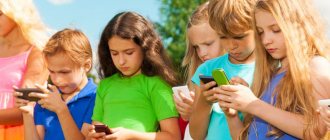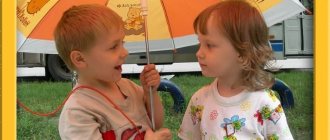Development of thinking in preschool children. How a person will grow up, what character qualities he will have, how active his thought process will be - is laid down in childhood. The preschool period is especially important. At this time, the body is undergoing intensive development, physical and mental, and the foundation of the individual is being laid.
Features of the development of thinking in a preschool child
Development of thinking in preschool children. During the preschool period, different types of thinking arise, and one becomes the basis for the emergence of another. The peculiarities of thinking depend on the acquired experience and knowledge that the child acquires on the path of growing up.
Thus, the prerequisites for thinking and understanding are laid from the very first months of life. The first rattle in a child’s life, the first actions with objects surrounding the baby - everything matters in establishing connections between a person and an object. Random actions can generate interest and attempts to repeat these actions again. For example, after hearing a rattle make sounds, your baby will shake it again to repeat the process.
In a small child, thinking cannot be conscious; it simply occurs as a consequence of the perception of reality. And only when the child begins to walk, gains motor activity, and thinking also actively develops. This stage begins when the child turns two years old. Moreover, initially thinking becomes a consequence of practical action. Without conscious brain function. Intelligence begins to develop when a child gets the opportunity to create something through games and educational, cognitive activities. As the child gains more and more knowledge, he learns to perform mental operations, and by the age of five he can analyze, compare, and generalize.
Types of thinking: stages of child development
Development of thinking in preschool children. The following types of thinking dominate in a preschooler:
- objective-active, which develops spurred by the child’s imagination; typical for children aged 1 to 2 years.
- visual-figurative, which develops on the basis of the child’s existing knowledge; typical for children aged 3 to 4 years.
- verbal-logical, since speech begins to play an important role in achieving any goal of the child; typical for children of older preschool age - 5-7 years.
Subject-effective thinking
The youngest preschoolers love to break toys. They are not aggressors releasing negative energy, they are explorers. The objects that surround the child are interesting to him, he wants to touch them and take them apart. One action follows another. Speech is not important here, and the little ones do not yet have the ability to speak and explain their actions. The child thinks with his hands, exploring the properties of each object.
Visual-figurative type of thinking
When a child turns three or four years old, he already owns certain images that he actively uses in play. At the same time, objective-active thinking occurs; visual-figurative thinking simply becomes its continuation.
Verbal and logical thinking
At the age of five, preschoolers are already actively chatting, can analyze information, and give a detailed answer. They use speech in play and in everyday life; children remember that with the help of speech it is easier to achieve the desired result.
Abstract-symbolic
With this thinking, the child can separate the essential properties, signs of an object from the unimportant. The baby understands that a specific object can be replaced by another if it has the same characteristic features.
Creative thinking (creativity)
Creativity knows no boundaries or age differences. Whether at two or six years old, a child can enthusiastically build castles with blocks, knead plasticine, or move a brush with paint over a sheet of paper. At the same time, the child makes or draws what he wants, showing imagination. The child also sings, plays music, and dances with his soul.
conclusions
Preschool childhood is a period in a person’s life during which he acquires basic knowledge, skills and abilities, and his personality and intellect are formed. Among the most important mental new formations is thinking. It is with its help that the child gets to know himself and the world around him. Children of early age are characterized by a visual-effective type of thinking; in early preschool age, a visual-figurative type is formed, and in older preschool age, a verbal-logical type of thinking is revealed to the child (although figurative thinking remains the leading one). The development of a child’s thinking depends on experience, so it is very important to provide the child with the opportunity to see the world as widely as possible, as well as to train his thinking abilities. Thinking development activities can be interesting and exciting if done in a playful way. Choose exercises that you also like, because when both an adult and a child enjoy the process, the result will be much better.
Exercises and games to develop thinking in preschool children
In order for thinking to actively develop, you need to constantly work with your child. To help parents and educators there will be didactic, educational and entertainment classes, excursions, meetings with specialists, as well as regular games with children.
Development of imaginative thinking in a preschooler
To develop imaginative thinking, games that involve “gray cells” are suitable. For example, an adult invites a child to look at a picture that shows various objects, but they can all be called in one word. These can be dishes, various animals, items of clothing, furniture, and transport.
Another good option is puzzles. To assemble a picture from many elements, you need to present it as a whole, pay attention to individual details, look for common features in the illustration in order to obtain the integrity of the image.
You can offer to play the game “Everything on the shelves”. In this game, from a bunch of completely different objects, you need to find only those that correspond to specific characteristics.
Development of logical thinking in preschool children
Both oral games and the use of visual materials will help to develop logical thinking.
Good oral games such as:
- "Let's make up a fairy tale"
In this game, the adult starts the story, and the child’s task is to finish it.
- "Yes and no"
A game with leading questions to which the second player answers: “Yes” or “No.” The task is to eventually guess the item conceived by the first player.
- "Association"
In this exercise you are asked to select words by association: Dress - summer, fur coat... (winter);
squirrel - hollow, bear... (den), etc.
Using visual materials:
- Make shapes from counting sticks.
- Play the “labyrinth” in the picture, helping the character along the path.
- Use the illustrations to create a story.
Development of creative thinking
Creative thinking is impossible without the child’s imagination and ability to operate with images. You can offer your child the following games and exercises:
- find familiar images in the blot,
- create an object from several different parts,
- find the same signs in different pictures,
- guess what an object is based on an oral description.
- draw using unconventional drawing.
Development of spatial thinking
In order for a child to navigate the world around him, he needs to develop spatial skills. Games suitable for this:
- with matches, when you need to build new ones from created figures,
- with drawings, when the child is invited, for example, to play a pirate and find a treasure, following the plan,
- exercise “Farther - Closer”, when the child is asked to move objects to close and far distances at the request of a parent or teacher,
- With your eyes closed, following the teacher’s instructions, you need to draw a line on a piece of paper.
Development of thinking in preschoolers: what is important for parents to know
The development of a preschooler's thinking goes through three stages. Until the age of three, the baby develops visual and effective thinking. It is important for a child to see and do. Therefore, he grabs everything, puts it in his mouth, fiddles with it, and, as it seems to us adults, ruins everything: breaks toys, tears books, scratches pieces of furniture. In fact, he takes an interest in research and studies how the world works. The kid learns that paper tears, but cardboard does not. That the bread is soft and the cube is hard. That a live cat, if you pull it by the tail, scratches, but a toy cat is inactive. That the water in the bath is warm, but in the autumn puddle it is cold. The more such “discoveries” happen to your baby, the richer his understanding of the world will be. Parents face three challenges:
- do not interfere with the child’s exploration of surrounding objects (and this includes grass, stones, clothes, mother’s jewelry, and grandmother’s glasses);
- provide him with an adequate degree of safety (burns are too much, but the baby will be able to understand that hot is unpleasant);
- create conditions for the means at hand to help the baby make new discoveries: the lid of the pan rattles and rolls, stools have metal and wooden legs, semolina flows interestingly, boots come in leather and rubber. Let not everyone become Einsteins, but you can help in the development of thinking with the most ordinary household objects.
From the age of three to four years, visual-figurative thinking is formed.
The child also continues to explore this world with his hands, but now he already foresees the result of his actions. The baby learns to perform simple tasks according to diagrams. For example, he will enthusiastically find a way out of the maze and help the bunny escape from the wolf and help the apple get into the basket. Moms and dads will find various constructive games for the development of visual-effective and visual-figurative thinking in children of this age in the manual “We Play and Design. A book for parents and children 3-4 years old." The book not only describes various joint games for children and parents. The manual has a tab with geometric shapes of different colors. By folding circles, squares and stripes according to the pattern, the baby will see plants, animals and insects. And when performing your spontaneous tasks, the child will not only remember colors and shapes. He will develop fine motor skills and imagination. We play and design. Activities with children. 3-4 years
Beloshistaya A.V.
buy on book24 View similar
Visual support still plays an important role. This is especially evident when listening to books. A four-year-old child cannot simply imagine what fairy-tale characters and the events described look like; he needs to see them. Therefore, recommendations for developing the thinking of preschoolers include reading books with colorful illustrations. But with what joy adults then leaf through books with fairy tales and favorite pictures from their childhood!
By the age of five, the child’s interest in role-playing games increases, where more complex actions with other children appear. In most cases, in their games, boys and girls imitate the behavior of adults: “go to the store,” “get a haircut,” “cook food,” “drive a car.” Unlike younger children, five-year-olds in play do not rely on toys, but on the role they have taken on. They can already replace meaningful toys with objects that do not serve a specific function. For example, often in role-playing games, instead of pieces of paper and coins, children use leaves from trees as money and “have lunch” with empty dishes, only imitating the actions of a eater.
The level of speech development is related to the degree of development of thinking. By the age of five, speech becomes more complex and clear. At the same time, word creation develops. The child not only assimilates and copies the speech of adults, but also analyzes their words and, on the basis of this, forms his own. For example, a five-year-old girl, who had been in a hot bath for the first time, coyly said: “Oh, I felt sick from the heat.” Explaining what hotness is, the girl said: “Well, there are warm ones, and there are also cold and hot ones.”
The preschooler comprehends the causes of various phenomena and events, giving them a wide variety of explanations. He asks many questions: why the leaves are falling and the fairies are not visible, why the plane does not fall and winter comes. At the same time, children's assumptions surprisingly combine scientific expressions, references to technical analogies and naive ideas. A textbook example is the answer to the question “Where did the rivers come from?” boy Roma, five and a half years old. The kid answered: “Hydrogen mixed with oxygen, and it turned out water, then they dug a hole.” Considering that this version was expressed by a child in an experiment in the 1970s, it is not surprising that modern children make more “technological” and “computerized” assumptions. In them, adults will see a combination of magical ideas and the logic of direct perception.
Features of the development of thinking in preschoolers are also manifested through visual activity. Most children of middle preschool age are interested in drawing. Not everyone at this age draws people’s necks, ears, eyebrows, eyelashes, five fingers, clothes and shoes. It is important that the child depicts the head, torso and limbs in the form of sticks, as well as eyes, mouth and hair.
A five-year-old child can identify objects based on two characteristics: a pillow is soft and square, an apple is sweet and green, a glass vase is tall. He is able to understand that a chair and a table are pieces of furniture, an orange and a pear are fruits, and a car and a bus are transport. The manual “Learning to Think” will help him master and consolidate this knowledge. What is united with what? By working with this set of workbooks, your child will learn to identify unnecessary objects, understand the difference between a squirrel and a pigeon, and what a carriage and a tram have in common.
Learning to think. What is combined with what? Workbook
Salmina Nina Gavrilovna
In your opinion, “how is a raven similar to a desk?” Finding commonality in dissimilar (at first glance!) and differences in similar objects is one of the foundations of logical thinking for a future engineer or programmer, or indeed any sane person. The ability to operate with signs and symbols, to classify and generalize objects and their generic relationships based on the identification of essential features will become the basis for future mathematical success.
buy on book24 View similar
By the end of preschool age, the child begins to develop verbal-logical, or conceptual, thinking.
The child learns to independently find and assimilate general ways of solving problems and use different forms of generalization. With the help of speech, he expresses logical conclusions and argues his thoughts. Fully conceptual thinking will be formed by adolescence.
In elementary school, there are often situations when a child solves problems well using one type of thinking and experiences difficulties if the problem is formulated differently. In children, imaginative thinking still dominates. Their reasoning is illogical when comparing, for example, the number and size of objects. Therefore, parents should pay attention to the development of verbal and logical thinking in preschoolers. The sooner adults begin to develop this type of thinking, based on the child’s sensations and perceptions, the easier it will be for the child to learn at school.
The development of logical thinking in preschoolers, as in adults, is determined by the ability to use mental operations:
- analysis
is the mental division of a whole into its component parts. For example, a 4-year-old child already knows that chamomile has a root, a stem, leaves, an “eye” and petals. A more complex form of analysis is the understanding that, for example, to play hairdresser, you need to prepare a “workplace” and the necessary toy tools and equipment. In addition, you need not only a hairdresser, but also his client. Having analyzed and properly prepared for the game, the preschooler, while “serving the client,” will not be distracted by the fact that he is missing something; - synthesis
is the reverse operation when a preschooler assembles various parts into one whole. The most striking example of synthesis is the composition of letters and sounds into syllables, from syllables into words, from words into sentences, from sentences into text; - comparison
is the establishment of similarities and differences between objects. The child understands that the apple and cherry are round and red, but at the same time the fruit is large and has seeds, and the berry is small and has a seed inside; - generalization
is a combination of objects based on essential features. For example, a three-year-old child cannot yet generalize shoes, boots and sandals and call them in one word “shoes”. But he guesses to take a stick as a spoon; - classification
is the identification of similarities and differences in objects and phenomena. A five or six year old child can already classify flowers, distinguishing indoor, field, garden and forest flowers.
Completing tasks from the manual “Exploring the Properties of Objects” not only helps children study the properties and relationships between objects and phenomena, but also master mental operations. In general, this contributes to the development of logical thinking in older preschoolers, as well as speech, memory and imagination.
We explore the properties of objects. Benefit for children 5-7 years old
Kochurova Elena Eduardovna
The manual presents tasks aimed at developing in a 5-7 year old child the skills to understand the world, study the properties and relationships of objects and phenomena, find, remember, compare, juxtapose objects, and conduct simple analysis. Gradually increasing the complexity of tasks contributes to the development of memory, imagination, and thinking. In the process of specially organized, purposeful and systematic communication and cooperation with adults when performing tasks, the child intensively develops speech, develops the ability to reason, compare, and draw conclusions.
buy on book24 View similar
With your child you can play dominoes, puzzles and other board games that make your child think and analyze: “Opposites”, “Edible - Inedible”, “Confusion”, “Find a similar figure” and others. The development of logical thinking in preschoolers through educational games occurs easily and naturally. Give your little one different pictures so that he can describe and compare the scenes. Activities with Kosa cubes and their modifications (cubes with sides of two or four different colors; two colors are located on two sides diagonally) develop the child's hand-eye coordination, spatial perception and constructive abilities. The construction games “Tangram” and “Columbus Egg” also contribute to this. The parts from which a square or oval is assembled must be folded so that they form other shapes, for example, a hare, a turtle, a kangaroo. An important condition: it is necessary to use all the details of the original figure, and they should not overlap each other.
To develop the thinking of older preschoolers, it is not necessary to use only educational situations. A regular walk can be educational. On the way home, you can compare high and low houses, trees or people. Discuss with your child how a tram, trolleybus and train are similar and different. Observe the changing seasons and seasonal changes in clothing and shoes. When hanging New Year's decorations on the tree, discuss what materials they are made of, what shape the toys are and why they are not hung, for example, on a birch tree. In such moments, when mothers and fathers come up with tasks on the fly to develop the thinking of preschoolers, the authority of an intelligent parent with whom it is interesting to communicate is consolidated.
As you can see, there is nothing complicated about helping your baby develop thinking. All that is required from parents is love, consistency and diligence. Then your child will not only develop his abilities, which will help him in life, but will also remember his childhood with gratitude.
Teacher-psychologist Olga Ivanova










